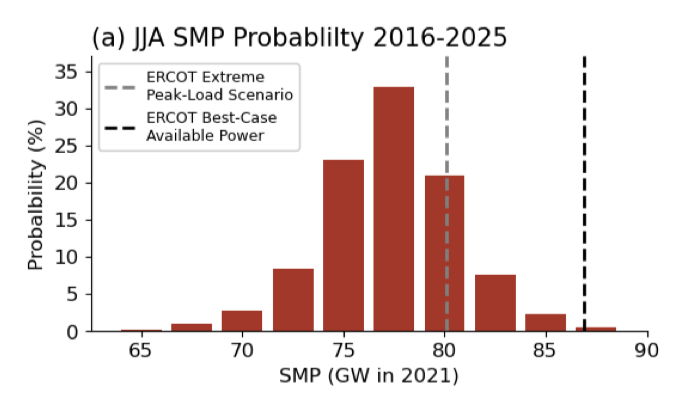
Why is Texas electricity both unreliable and expensive?
Let me tell you about some new research by my grad student, Jangho Lee.
A 🧵:
Let me tell you about some new research by my grad student, Jangho Lee.
A 🧵:
Using historical data we got from @ERCOT_ISO's web page, we developed a statistical model of electricity demand as a function of temperature and an inferred long-term trend of non-climate factors (e.g., population).
If we plug historical temperatures (ERA5) into the statistical model, we can reproduce almost exactly the historical power usage. This plot shows a comparison of seasonal maximum power: 

So now we can take a climate model ensemble (the CESM-LE) and estimate a probability distribution of power demand for winter and summer 2021. To do this, we take temperatures from 2016-2025 in the model, but use non-climate factors for 2021.
Here is the distribution of seasonal maximum power demand (the highest hourly power demand during the entire season) for summer 2021. The red bars are what we get using temperatures from the CESM-LE. 

The black line on that plot is ERCOT's estimate of maximum available power, 87 GW. We see that demand can get very close to max supply. More quantitatively, there is a 20% chance that demand will be within 7 GW of maximum supply.
At first blush, this might look OK — after all, in most cases, supply is sufficient to satisfy demand.
But then, this happens:
But then, this happens:

So if everything goes right, then ERCOT can supply power during the hottest summer days and most of the coldest winter days.
But there's no margin if everything doesn't go right. If a few power plants go offline unexpectedly, you're faced with a power shortage.
But there's no margin if everything doesn't go right. If a few power plants go offline unexpectedly, you're faced with a power shortage.
Put simply: there is zero margin for error on the ERCOT grid.
Note that we could alleviate that if we connected the ERCOT grid to the rest of the US. With such connections, we could just wheel in some power from other states if supply gets tight.
Note that we could alleviate that if we connected the ERCOT grid to the rest of the US. With such connections, we could just wheel in some power from other states if supply gets tight.
But, according to Rick Perry, we would rather have power blackouts.
I'm going to go out on a limb here and say that Rick does not speak for the majority of Texans on this issue.
I'm going to go out on a limb here and say that Rick does not speak for the majority of Texans on this issue.

There are a few things worth emphasizing here. The market was designed with no incentives for there to be any excess capacity in the market because excess capacity costs money and the designers of the market wanted to save consumers money.
But as supply and demand converge, the price of electricity on the ERCOT market shoots up. As is well documented, during the winter storm the price of electricity was 100 times the normal price.
Shortages in power are therefore tremendously costly for the general public. We will literally be paying the costs of the one-week 2021 winter storm for decades. @TexasMonthly
texasmonthly.com/news-politics/…
texasmonthly.com/news-politics/…
More generally, the deregulated Texas energy market is costs consumers money [although there are many reasons for this].
wsj.com/articles/texas…
wsj.com/articles/texas…
So, when Texas deregulated their energy market, they produced an electricity market with higher prices and less reliability.
Let's hope that @ERCOT_ISO & @PUCTX will redesign the market to — oh, I don't know — deliver reliable power at lower prices.
houstonpublicmedia.org/articles/news/…
Let's hope that @ERCOT_ISO & @PUCTX will redesign the market to — oh, I don't know — deliver reliable power at lower prices.
houstonpublicmedia.org/articles/news/…
Importantly: they need to design incentives into the market to increase the supply of power, but do it without ripping off consumers.
The problem is that the energy companies will oppose that since they like ripping consumers off.
The problem is that the energy companies will oppose that since they like ripping consumers off.
Our paper is submitted and presently undergoing peer review. You can get a pre-print here: eartharxiv.org/repository/vie…
We would love to get feedback, so feel free to email us if you have any comments.
We would love to get feedback, so feel free to email us if you have any comments.
• • •
Missing some Tweet in this thread? You can try to
force a refresh







